#Tourist places nearby Ajanta and Ellora
Explore tagged Tumblr posts
Text
5 Budget-Friendly Tourist Spots in Aurangabad:

Aurangabad also known as Chhatrapati Sambhaji Nagar is a beautiful city located in Maharashtra. Situated in the hilly terrain of the Deccan region, this is the fifth most populous city in Maharashtra. Aurangabad is famous for its historical monuments including ancient caves, temples and other attractions. The city is also a major production centre of cotton. The Aurangabad city is also known as the city of gates because there are many ancient forts in the city.
If you are willing to explore Aurangabad in Budget budget-friendly deal then renting a car will be the best option for you. You can search for car rental in Aurangabad, which allows you to explore the city at your own pace and in cost cost-effective deal. Also by renting a car, you can visit the famous places in Aurangabad in a shorter amount of time and according to your preferences. So now let’s discuss famous tourist spots you should consider visiting in Aurangabad.
5 budget-friendly tourist spots to visit in Aurangabad:
If you want to visit some of the famous tourist spots in Aurangabad and in a budget-friendly deal you have to choose better transportation, travel during the off-season, and affordable accommodation. Here are five famous tourist spots you can visit in Aurangabad at an affordable price.
Ajanta caves:
The Ajanta caves are one of the budget- friendly tourist destination places in Aurangabad. Located near the Sahyadri Hills of Maharashtra, this place is a UNESCO world heritage site. The place is an ideal destination point for tourists who have a keen interest in history and want to explore the region's past. There are numerous paintings and Buddhist rock-cut architecture. A tourist can do various activities here like exploring the paintings and architecture and exploring the surrounding hills.
This cave is located at a distance of 90 km away from Aurangabad and takes up to 3 hours to reach there. The time of this cave is from 9 am to 5 pm and it takes up to two to three hours to explore the cave. The entry fee for this cave for Indian tourists is Rs 35 per person while for a foreign tourist, the price is Rs 600 per person. This is not the actual price and may vary depending on the season. You can also choose a tour- guide but you have to pay a certain amount from Rs 8000 to 16,000 depending upon the length of the tour.
Ellora caves:
Another budget-friendly tourist destination is Ellora Caves. The cave located near Ellora village is also a UNESCO World Heritage site. The cave is famous for its temples and other various architectures and the world famous Kailash Temple is located here. Tourists can do various activities here from exploring the ancient architecture and visiting the nearby village areas.
The cave is located at a distance of 30 km away from Aurangabad city. If you are looking for a convenient ride you can rent a car by searching for Best car rental in Aurangabad. The time of this cave is from 6 am to 6 pm (except Tuesday) . It takes up to 2 hours to explore the cave. The entry fees of this cave for an Indian visitor are Rs 40 and for a foreign traveller, the price is Rs 600. If you are willing to take a guided tour then the price will start from Rs 4000 and it may increase depending on the length of the tour.
Bibi ka Maqbara:
The Bibi ka Maqbara is a tomb which was built to commemorate the wife of Mughal emperor Aurangzeb. This is located in Begumpura region, at a distance of 3 km away from Aurangabad city. This tomb is also called the Taj of the Deccan. This place is famous among tourists, who want to explore the architectural marvels of Mughal-style gardens and water channels.
The time of this cave is from 8 am to 8 pm. The entry fee to visit this Maqbara is Rs 25 for an Indian visitor and Rs 300 for a foreign visitor. The prices may change depending on the season and you can either book your ticket online or purchase it from the ticket counter.
Daulatabad Fort:
The Daulatabad fort also known as the Deogiri fort is a fortified citadel located in the Daulatabad village. This citadel stands on a hill at an elevation of 200 metres. This is one of the most powerful forts during medieval times consisting of a multi-layered defence system and its unique location. This fort is one of the best-preserved monuments of the city. This is an ideal tourist destination point for tourists and from here a tourist can explore the beautiful view of the surrounding areas.
The Daulatabad fort is located at a distance of about 16 Km away from Aurangabad. The time for this fort is from 9 am to 6 pm and usually takes up to 3 hours to explore the fort and its surrounding areas. The entry fee for this fort is Rs 10 for an Indian visitor and Rs 100 for a foreign visitor. You can also hire a tour guide but it will require an additional charge of Rs 1600 and the price depends upon the tour length.
Grishneshwar Temple:
The last place you can consider visiting in Aurangabad is Grishneshwar Temple. This temple is one of the 12 temples in the city and a protected site. This temple is located north-west of Aurangabad city at a distance of around 35-40 Km. A tourist can witness various rituals performed in the temple. However, before visiting this temple always check the timing as it varies depending upon a particular day of the week. There are also certain rules and regulations issued by the temple authority so you need to follow them.
Conclusion:
These are the five famous budget-friendly tourist spots you can visit here. For efficient transportation, you can search for car rental in Aurangabad. By renting a car it helps you to explore the nearby areas of the city at your own pace. You can create a memorable journey in Aurangabad while witnessing its rich historical and cultural importance.
1 note
·
View note
Text
Top 10 popular destinations in Maharashtra
Maharashtra known for its rich cultural heritage and diverse landscape, this state is located in western India. Maharashtra state offers many attractions for different types of travelers preference. Ranging from ancient caves recounting historical stories to picturesque beaches perfect for unwinding. From vibrant cities pulsating with energy to tranquil hill stations that offer solace, Maharashtra has it all! Prepare to travel on a thrilling journey as we describe the historical, natural, and cultural significance of Maharashtra state. In this article, we provide small information about top 10 must visit destinations in Maharashtra. That will leave you awe:inspired and craving for more. Get ready to be amazed!
Mumbai : The financial and entertainment capital of India, Mumbai is a bustling metropolis with endless attractions. With its iconic landmarks such as the Gateway of India and Marine Drive, alongside bustling street markets and a lively nightlife scene, Mumbai seamlessly blends tradition with modern elements. Pune : Pune is a leading educational and cultural hub of Maharashtra, also called as "Oxford of the East". Pune boasts attractions like the Aga Khan Palace, Shaniwar Wada, and Sinhagad Fort, which provide fascinating insights into the region's history. Lonavala and Khandala : Nestled in the Sahyadri mountain range, Lonavala and Khandala are famous hill stations known for their breathtaking views and pleasant weather. Offering a peaceful getaway from the busy city life, these twin hill:stations are made even more enchanting with striking attractions like Bhushi Dam, Rajmachi Fort, and Karla Caves. Mahabaleshwar : Mahabaleshwar is a picturesque hill station & situated at the highest point of the Western Ghats famous for its scenic beauty and strawberry farms. Mahabaleshwar has many viewpoints to visit including iconic spots like Arthurs Seat and Needle Hole Point. Provide visitors with magnificent panoramas of the nearby valleys and cascades in the town. Aurangabad : With the presence of two UNESCO World Heritage Sites : Ajanta and Ellora Caves, Aurangabad steals the hearts of all history enthusiasts who visit. These ancient rock:cut caves showcase exquisite Buddhist and Hindu art and architecture, dating back to the 2nd century BCE. Nashik : Known as the wine capital of India, Nashik is situated on the banks of the holy Godavari River. In addition to its flourishing wine industry, Nashik is also renowned for its ancient temples, including the Kala Ram Mandir and Trimbakeshwar Shiva Temple, attracting tourists from around the country. Alibaug : Located just a short ferry ride away from Mumbai, Alibaug is a popular coastal destination known for its pristine beaches and historical forts. The famous Alibaug Beach and Kashid Beach offer a tranquil escape, while the 17th:century sea fort of Murud:Janjira provides a glimpse into the region's past. Kolhapur : Enriched with Maratha culture and ancient traditions, Kolhapur is a city that can transport visitors to a bygone era. The magnificent Mahalaxmi Temple and the opulent New Palace showcase the city's architectural grandeur, while the vibrant local cuisine, especially the famous Kolhapuri Misal, delights food enthusiasts. Matheran : As the smallest hill station in India, Matheran offers a unique experience due to its lack of vehicles. It is a place where one can fully immerse themselves in nature by exploring scenic trails, riding in toy trains, and enjoying panoramic views from vantage points like the Louisa Point and Panorama Point. Ratnagiri : Nestled along the breathtaking Konkan coast, Ratnagiri is a coastal town known for its pristine beaches and historical significance. The birthplace of Indian freedom fighter Lokmanya Tilak, Ratnagiri offers attractions like the Ratnadurg Fort, Thibaw Palace, and Ganpatipule Beach, providing a perfect blend of history and nature. In conclusion, Maharashtra is a treasure trove of diverse destinations that cater to all kinds of travelers. From the urban charm of Mumbai and Pune to the tranquil hills and coastal retreats, visitors can immerse themselves in the rich tapestry of history, culture, and natural beauty that this state offers. Whether one is seeking adventure, spirituality, or simply a relaxing getaway, these top 10 destinations in Maharashtra promise an unforgettable experience for graduate school students and all other travelers alike.
0 notes
Text
Ajanta and Ellora Cave Temples
Buddhist Tour in India offers here more details about Ajanta and Ellora. Ajanta and Ellora caves are considered to be one of the most important #tourist_destinations in the #world owing to the magnificent paintings of #Ajanta and well-carved sculptures of #Ellora. The rock-cut caves containing carvings are the finest example of #Indian_paintings and #sculpture. #Ajanta_Buddhist_Site #buddhisttourinindia #buddhist_Package Buddhist Tour In India Contact: +91-9711845432 / +91-9616731175Link: http://buddhisttourinindia.com/buddhist-pilgrimage-destination/about-ajanta-ellora-buddhist-places-maharashtra-india.aspx

#Ajanta and Ellora Cave Temples#About Ajanta and Ellora Cave Temples#Local Sightseeing of Ajanta & Ellora#Tourist places nearby Ajanta and Ellora#how to reach Ajanta and Ellora Caves#best time to visit Ajanta and Ellora Caves#Buddhist Tour in India
1 note
·
View note
Text
INDIAN ROCK-CUT ARCHITECTURE
INCREDIBLE INDIA BEYOND AND BEFORE TAJ MAHAL
Taj Mahal – one of the seven wonders of the world, undoubtedly is one of the best things to see in India. I just mentioned one of the best…yes, you know why – with-out any doubt, there are so many places in India which are just over-shadowed because of the Taj. Don’t mind, being in Travel business I too love Taj, I’ve already been to Taj so many times and taken hundreds of Tourists to experience this wonderful, timeless magic now and yet never get enough of it. The reality is that India is a diverse, multi-cultured nation, despite this tourists usually prefer Taj and combines it with Jaipur and Delhi at max. Isn’t it unfair to other parts of India with immense beauty receives a cold-shoulder! There are so many places to visit in India beyond just the iconic Taj Mahal which make India as Bucket of Incredible India
Here I would try my best to Highlight Few Places and Monuments undoubtedly equally beautiful Taj, an example itself of Ancient Indian Architects glorifying Indian craftsmanship, technology and Hardship Where Rock-Cut Architect was introduced before 3rd century B.C.
INDIAN ROCK-CUT ARCHITECTURE:
Indian rock-cut architecture is more various and found in greater abundance in India than any other form of rock-cut architecture around the world. Rock-cut architecture is the practice of creating a structure by carving it out of solid natural rock. Rock that is not part of the structure is removed until the only rock left makes up the architectural elements of the excavated interior. Indian rock-cut architecture is mostly religious in nature.
As per historical evidence available there are more than 1,500 known rock-cut structures in India. Many of these structures contain artwork of global importance, and most are adorned with exquisite stone carvings. These ancient and medieval structures represent significant achievements of structural engineering and craftsmanship. The effort expended often astonishes visitors, but seen from one aspect, a rock-cut structure is a decorated rock quarry; most of the stone removed was typically put to economic use elsewhere.
Few of Rock-cut monuments in India:
Badami Cave Temples : (HANDCRAFTED WONDER)
The Badami cave temples are a complex of Hindu and Jain cave temples located in Badami, a town in the Bagalkot district in northern part of Karnataka, India. The caves are considered an example of Indian rock-cut architecture, especially Badami Chalukya architecture, which dates from the 6th century. Badami was previously known as Vataapi Badami, the capital of the early Chalukya dynasty, which ruled much of Karnataka from the 6th to the 8th century. Badami is situated on the west bank of a man-made lake ringed by an earthen wall with stone steps; it is surrounded on the north and south by forts built in later times.
The Badami cave temples represent some of the earliest known examples of Hindu temples in the Deccan region. They along with the temples in Aihole transformed the Malaprabha River valley into a cradle of temple architecture that influenced the components of later Hindu temples elsewhere in India.
Caves 1 to 4 are in the escarpment of the hill in soft Badami sandstone formation, to the south-east of the town. In Cave 1, among various sculptures of Hindu divinities and themes, a prominent carving is of the Tandava-dancing Shiva as Nataraja. Cave 2 is mostly similar to Cave 1 in terms of its layout and dimensions, featuring Hindu subjects of which the relief of Vishnu as Trivikrama is the largest. The largest cave is Cave 3, featuring Vishnu-related mythology, and it is also the most intricately carved cave in the complex. Cave 4 is dedicated to revered figures of Jainism. Around the lake, Badami has additional caves of which one may be a Buddhist cave. Another cave was discovered in 2015, about 500 metres (1,600 ft) from the four main caves, with 27 Hindu carvings.

Bagh Caves
The Bagh Caves are a group of nine rock-cut monuments, situated among the southern slopes of the Vindhyas in Bagh town of Dhar district in Madhya Pradesh state in central India. These monuments are located at a distance of 97 km from Dhar town.

Ellora Caves
Ellora (एलोरा) is a UNESCO World Heritage Site located in the Aurangabad district of Maharashtra, India. It is one of the largest rock-cut monastery-temple cave complexes in the world, featuring Hindu, Buddhist and Jain monuments, and artwork, dating from the 600–1000 CE period. Cave 16, in particular, features the largest single monolithic rock excavation in the world, the Kailasha temple, a chariot shaped monument dedicated to Lord Shiva. The Kailasha temple excavation also features sculptures depicting the gods, goddesses and mythologies found in Vaishnavism, Shaktism as well as relief panels summarizing the two major Hindu Epics.
Although the caves served as monasteries, temples and a rest stop for pilgrims, the site's location on an ancient South Asian trade route also made it an important commercial centre in the Deccan region. It is 29 kilometres (18 miles) north-west of Aurangabad, and about 300 kilometres (190 miles) east-northeast of Mumbai. Today, the Ellora Caves, along with the nearby Ajanta Caves, are a major tourist attraction in the Marathwada region of Maharashtra and a protected monument under the Archaeological Survey of India.
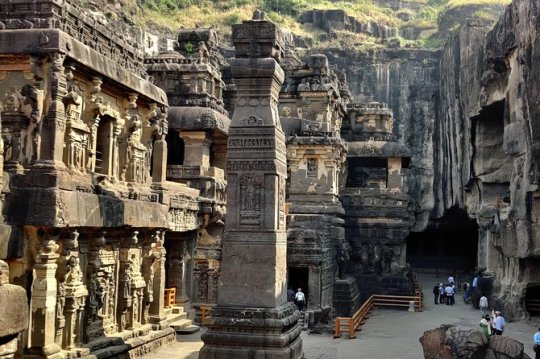
Gopachal
Siddhachal Caves or Gopachal Rockcut monuments are Jain cave monuments and statues carved into the rock face inside the Urvahi valley of the Gwalior Fort in northern Madhya Pradesh, India. There are the most visited among the five groups of Jain rock carvings on the Gwalior Fort hill. They were built over time starting in the 7th-century, but most are dated to the 15th-century CE. Many of the statues were defaced and destroyed under the orders of the Muslim Emperor Babur of the Mughal dynasty in the 16th century, while a few repaired and restored after the fall of the Mughal dynasty and through the late 19th century.
The statues depict all 24 Tirthankaras. They are shown in both seated Padmasana posture as well as standing Kayotsarga posture, in the typical naked form of Jain iconography. The reliefs behind some of them narrate scenes from the Jain legends. The site is about 2 kilometres (1.2 mi) from the South-East Group of Gopachal rock cut Jain monuments and about 1 kilometre (0.62 mi) northwest of the Teli ka Mandir within the Gwalior Fort.
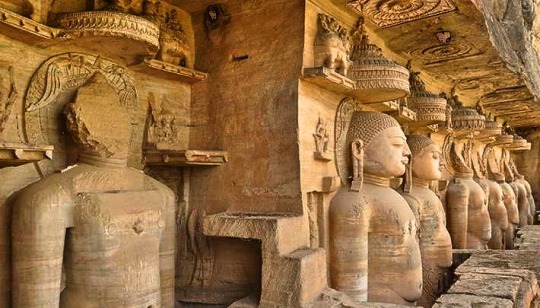
Kanheri Caves
The Kanheri Caves (Kānherī-guhāḥ) are a group of caves and rock-cut monuments cut into a massive basalt outcrop in the forests of the Sanjay Gandhi National Park, on the former island of Salsette in the western outskirts of Mumbai, India. They contain Buddhist sculptures and relief carvings, paintings and inscriptions, dating from the 1st century CE to the 10th century CE. Kanheri comes from the Sanskrit Krishnagiri, which means black mountain.
The site is on a hillside, and is accessible via rock-cut steps. The cave complex comprises one hundred and nine caves. The oldest are relatively plain and unadorned, in contrast to later caves on the site, and the highly embellished Elephanta Caves of Mumbai. Each cave has a stone plinth that functioned as a bed. A congregation hall with huge stone pillars contains a stupa (a Buddhist shrine). Rock-cut channels above the caves fed rainwater into cisterns, which provided the complex with water. Once the caves were converted to permanent monasteries, their walls were carved with intricate reliefs of Buddha and the Bodhisattvas. Kanheri had become an important Buddhist settlement on the Konkan coast by the 3rd century CE.
Most of the caves were Buddhist viharas, meant for living, studying, and meditating. The larger caves, which functioned as chaityas, or halls for congregational worship, are lined with intricately carved Buddhist sculptures, reliefs, pillars and rock-cut stupas. Avalokiteshwara is the most distinctive figure. The large number of viharas demonstrates there was a well organized establishment of Buddhist monks. This establishment was also connected with many trade centers, such as the ports of Sopara, Kalyan, Nasik, Paithan and Ujjain. Kanheri was a University center by the time the area was under the rule of the Maurayan and Kushan empires In the late 10th century, the Buddhist teacher Atisha (980–1054) came to the Krishnagiri Vihara to study Buddhist meditation under Rahulagupta.

Lenyadri Caves
Lenyadri, sometimes called Ganesa Lena, Ganesh Pahar Caves, or Suleman Caves, represents a series of about 30 rock-cut Buddhist caves, located about 5km north of Junnar in Pune district in the Indian state of Maharashtra. Other caves surrounding the city of Junnar are: Manmodi Caves, Shivneri Caves and Tulja Caves.
· Cave 7, originally a Buddhist vihara, has been adapted as a Hindu temple dedicated to the god Ganesha. It is one of the Ashtavinayak shrines, a set of the eight prominent Ganesha shrines in Western Maharashtra. Twenty-six of the caves are individually numbered. The caves face to the south and are numbered serially from east to west. Caves 6 and 14 are chaitya-grihas (chapels), while the rest are viharas (dwellings for monks). The latter are in the form of dwellings and cells. There are also several rock-cut water cisterns; two of them have inscriptions. The layout of the caves, in general, are similar in pattern and shape. They generally have one or two sides with two long benches for occupants' use.
The caves date from between the 1st and 3rd century AD; the Ganesha shrine situated in Cave 7 is dated to the 1st century AD, though the date of conversion to a Hindu shrine is unknown. All of the caves arise from Hinayana Buddhism
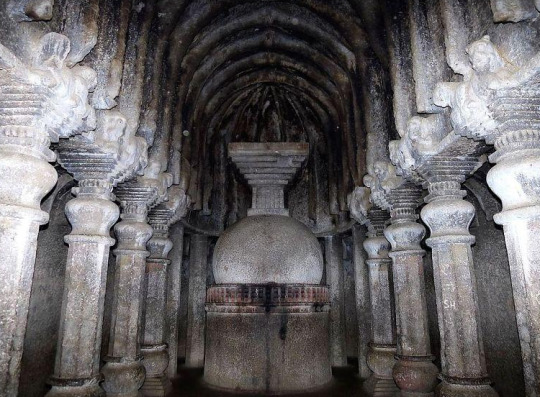
Mahabalipuram Caves
The Group of Monuments at Mahabalipuram is a collection of 7th- and 8th-century CE religious monuments in the coastal resort town of Mahabalipuram, Tamil Nadu, India and a UNESCO World Heritage Site. It is on the Coromandel Coast of the Bay of Bengal, about 60 kilometres (37 mi) south of Chennai.
The site has 40 ancient monuments and Hindu temples, including one of the largest open-air rock reliefs in the world: the Descent of the Ganges or Arjuna's Penance. The group contains several categories of monuments: ratha temples with monolithic processional chariots, built between 630 and 668; mandapa viharas (cave temples) with narratives from the Mahabharata and Shaivic, Shakti and Vaishna inscriptions in a number of Indian languages and scripts; rock reliefs (particularly bas-reliefs); stone-cut temples built between 695 and 722, and archaeological excavations dated to the 6th century and earlier.The monuments were built during the Pallava dynasty. Known as the Seven Pagodas in many colonial-era publications, they are also called the Mamallapuram temples or Mahabalipuram temples in contemporary literature. The site, restored after 1960, has been managed by the Archaeological Survey of India.

Pancha Rathas
Pancha Rathas (also known as Five Rathas or Pandava Rathas) is a monument complex at Mahabalipuram, on the Coromandel Coast of the Bay of Bengal, in the Kancheepuram district of the state of Tamil Nadu, India. Pancha Rathas is an example of monolithic Indian rock-cut architecture. The complex was carved during the reign of King Narasimhavarman I (630–668 AD): the idea of realising monolithic buildings, an innovation in Indian architecture, is attributed to this ruler. The complex is under the auspices of the Archaeological Survey of India (ASI) and is part of the UNESCO World Heritage site inscribed by UNESCO as Group of Monuments at Mahabalipuram.
Each of the five monuments in the Pancha Rathas complex resembles a chariot (ratha), and each is carved over a single, long stone or monolith, of granite which slopes in north-south direction with a slight incline. Though sometimes mistakenly referred to as temples, the structures were never consecrated because they were never completed following the death of Narasimhavarman I The structures are named after the Pancha Pandavas and their common wife Draupadi, of epic Mahabharata fame. In order of their size, they include the Dharmaraja Ratha, Bhima Ratha, Arjuna Ratha, Nakula Sahadeva Ratha, and Draupadi Ratha.

Kazhuku Malai
The Sculptures in the only single-stone temple car at Kazhuku Vettuvan Coil are discussed. Also described are the sculptures, the paintings and the storeyed temple of Pandyas.The five core units of the sculptures in cave temples, in single-stone temple cars, in ��built-up temples, in the eight storeyed temple towers, and paintings of the Pandya period. The cave-temple tradition of the Pallavas was followed and perfected by the Pandyas. The first Pandya cave-temple is in Malakadikurichi of Tirunelveli District. Cave-temples at places like Othakadai in Madurai District, Thirupparankundram, Pillayarpatti Cave-temple near Karaikudi, Kundrakudi, Trichy, and Chokkampatti have numerous sculptures in them.The Single-stone temple car sculptures at Kazhukumalai in Tirunelveli District earned the name “Southern Ellora” for the place. Paintings of the early Pandyas, sculptures of building type at Kazhukumalai, a few remnants of early Pandyas’ built-up temples, temple-towers and Mandapas constructed by later Pandyas and also their paintings reveal the interest of Pandyas in these arts.

Pandavleni Caves
The Nasik Caves, or sometimes Pandavleni Caves (or Pandu Lena,[1] Pandu Caves or Trirashmi Leni, Trirashmi being the name of the hills in which the caves are located, Leni being a Marathi word for caves), are a group of 24 caves carved between the 1st century BCE and the 3rd century CE, though additional sculptures were added up to about the 6th century, reflecting changes in Buddhist devotional practices mainly. Buddhist sculptures are a significant group of early examples of Indian rock-cut architecture initially representing the Hinayana tradition. Most of the caves are viharas except for Cave 18 which is a chaitya of the 1st century BCE. The style of some of the elaborate pillars or columns, for example in caves 3 and 10, is an important example of the development of the form. The location of the caves is a holy Buddhist site and is located about 8 km south of the center of Nashik (or Nasik), Maharashtra, India, The "Pandavleni" name sometimes given to the Nasik Caves has nothing to do with the characters Pandavas, characters in the Mahabharata epic. Other caves in the area are Karla Caves, Bhaja Caves, Patan Cave and Bedse Caves.

Pitalkhora
The Pitalkhora Caves, in the Satamala range of the Western Ghats of Maharashtra, India, are an ancient Buddhist site consisting of 14 rock-cut cave monuments which date back to the third century BCE, making them one of the earliest examples of rock-cut architecture in India. Located about 40 kilometers from Ellora, the site is reached by a steep climb down a flight of concrete stairs, past a waterfall next to the caves.The caves are cut in a variety of basalt rock, but some of the caves have crumbled and are damaged. Out of the 14, four are chaityas (one housing votive stupas, one apsidal and single-cell) and the rest are viharas. All the caves belong to the Hinayana period, but the reasonably well preserved paintings are of the Mahayana period. The caves are in two groups, one of 10 caves and the second of four. It is believed that Pitalkhora can be identified with Ptolemy’s "Petrigala" as well as the "Pitangalya" of Mahamayuri, a Buddhist chronicle. The inscriptions date from c. 250 BCE to the 3rd and 4th centuries CE.
The site shows statues of elephants, two soldiers of which one is intact, a damaged Gaja Lakshmi icon, and an ancient rainwater harvesting system. These caves have been significant in helping establish the chronology of cave building in the Ajanta-Ellora region.

Undavalli caves,
The Undavalli Caves, a monolithic example of Indian rock-cut architecture and one of the finest testimonials to ancient viswakarma sthapathis, are located in Undavalli of Guntur district in the Indian state of Andhra Pradesh. The caves are located 6 km south west from Vijayawada, 22 km north east of Guntur City of Andhra Pradesh. It is one of the centrally protected monuments of national importance.These caves are said to be found in 7th century. They are associated with the Vishnukundi kings of 420-620 CE. These caves are dedicated to Anantha Padmanabha and Lord Narashimha. Buddhist monks used these as rest houses.
These caves were carved out of solid sandstone on a hillside in the 4th to 5th centuries CE. There are several caves and the best known largest one has four stories with a huge recreated statue of Vishnu in a reclining posture, sculpted from a single block of granite inside the second floor. Many Buddhist artifacts and stupas in Andhra were converted into Hindu temples and deities and undavalli is an example. It was originally a Jain cave resembling the architecture of Udayagiri and Khandgiri..The main cave is one of the earliest examples of Gupta architecture, primarily primitive rock-cut monastery cells carved into the sandstone hills. Initially, the caves were shaped as a Jain abode and the first-floor abode still retains the Jain style; the vihara exhibits Jain monastics and includes tirthankara sculptures. This first level of the cave is a carved vihara and includes Buddhist artwork. The site served as the Bhikkhu monastic complex during ancient period. The walls of the caves display sculptures carved by skilled craftsmen. The caves are surrounded by green countryside. From the high hill above the cave overlooking the Krishna River many fine specimens of rock-cut architecture can be seen.
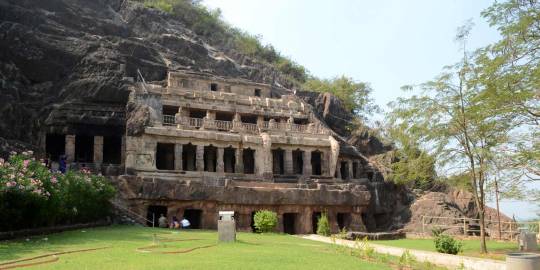
Varaha Cave Temple
Varaha Cave Temple (also Varaha Mandapa) is a rock-cut cave temple located at Mamallapuram, on the Coromandel Coast of the Bay of Bengal in Kancheepuram District in Tamil Nadu, India. It is part of the hill top village, which is 4 kilometres (2.5 mi) to the north of the main Mahabalipurm sites of rathas and the Shore Temple. It is an example of Indian rock-cut architecture dating from the late 7th century. The temple is one of the finest testimonial to the ancient Hindu rock-cut cave architecture, out of many such caves also called mandapas. Part of the Group of Monuments at Mahabalipuram, the temple is a UNESCO World Heritage Site as inscribed in 1984 under criteria i, ii, iii and iv. The most prominent sculpture in the cave is that of the Hindu god Vishnu in the incarnated form of a Varaha or boar lifting Bhudevi, the mother earth goddess from the sea. Also carved are many mythical figures.
Varaha Cave Temple is located on the hills of Mahabalipuram town, 4 kilometres (2.5 mi) to the north of the main Mahabalipurm sites of rathas and Shore Temple, on the Coromandel Coast of the Bay of Bengal of the Indian Ocean. Now in the Kanchipuram district, it is approximately 58 kilometres (36 mi) from Chennai city (previously Madras) and about 20 miles (32 km) from Chingelpet.
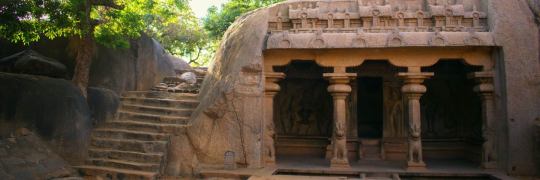
Masroor Temple at Kangra
The Masrur Temples, also referred to as Masroor Temples or Rock-cut Temples at Masrur, is an early 8th-century complex of rock-cut Hindu temples in the Kangra Valley of Beas River in Himachal Pradesh, India. The temples face northeast, towards the Dhauladhar range of the Himalayas. They are a version of North Indian Nagara architecture style, dedicated to Shiva, Vishnu, Devi and Saura traditions of Hinduism, with its surviving iconography likely inspired by a henotheistic framework. Though a major temples complex in the surviving form, the archaeological studies suggest that the artists and architects had a far more ambititious plan and the complex remains incomplete. Much of the Masrur's temple's sculpture and reliefs have been lost. They were also quite damaged, most likely from earthquakes.The temples were carved out of monolithic rock with a shikhara, and provided with a sacred pool of water as recommended by Hindu texts on temple architecture. The temple has three entrances on its northeast, southeast and northwest side, two of which are incomplete. Evidence suggests that a fourth entrance was planned and started but left mostly incomplete, something acknowledged by the early 20th-century colonial era archaeology teams but ignored leading to misidentification and erroneous reports. The entire complex is symmetrically laid out on a square grid, where the main temple is surrounded by smaller temples in a mandala pattern. The main sanctum of the temples complex has a square plan, as do other shrines and the mandapa. The temples complex features reliefs of major Vedic and Puranic gods and goddesses, and its friezes narrate legends from the Hindu texts.
The temple complex was first reported by Henry Shuttleworth in 1913 bringing it to the attention of archaeologists. They were independently surveyed by Harold Hargreaves of the Archaeological Survey of India in 1915. According to Michael Meister, an art historian and a professor specializing in Indian temple architecture, the Masrur temples are a surviving example of a temple mountain-style Hindu architecture which embodies the earth and mountains around it.
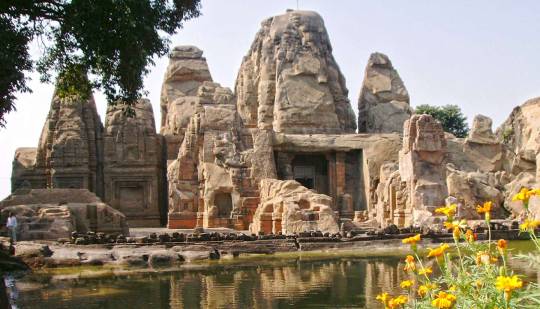
Bojjannakonda Buddhist Site,
Bojjannakonda and Lingalakonda are two Buddhist rock-cut caves on adjacent hillocks, situated near a village called Sankaram, which is a few kilometres away from Anakapalle, Vishakhapatnam in the Indian state of Andhra Pradesh. The sites are believed to date between 4th and 9th Century A.D, when the Buddhism (Hinayana, Mahayana, and Vajrayana) flourished at Sankaram (Sangharam as it was called then). The real name of Bojjannakonda was actually Buddina Konda but the people can't pronounce it properly by telling the name repeatedly so it was changed to Bojjannakonda . Sankaram, a small village, is situated about a mile to the east of Anakapalli in the Visakhapatnam district of Andhra Pradesh. A short distance to the north of the village are two hills, the one on the east called Bojjannakonda and the other on the west called Lingalakonda, both of which are surrounded by paddy fields. The hills contain numerous monolithic stupas, rock-cut caves, chaityas and monasteries forming one of the most remarkable Buddhist establishments in Andhra Pradesh during the period from the 4th to the 9th Century CE. The name of the village Sankaram is evidently a corruption of Sangharam (Boudha-arama, i.e., vihara) as these Buddhist establishments are generally known.

Guntupalle Buddhist Site,
The Guntupalle or Guntupalli Group of Buddhist Monuments is located near Kamavarapukota, West Godavari district, in the state of Andhra Pradesh in India. It is around 40 km away from Eluru. The rock-cut part of the site has two Buddhist caves, a chaitya hall and a large group of stupas. The chaitya hall has a rare carved stone entrance replicating wooden architecture, a simpler version of that at the Lomas Rishi Cave.There are remains of structural buildings in brick and stone, including remains of two vihara made of brick, as well as excavated caves at two levels, including an unusual structural chaitya hall (that is, one built above ground). The core of this consists of the stone stupa with an enclosed path around it allowing ritual parikrama (circumambulation). They mostly date to 200-0 BCE, with some sculptures added later. The main building above ground is in brick, around a stone stupa, with over 30 smaller stupas on a terrace in front of it. There are ruins of two other buildings.
During excavation, three relic caskets were found. The caskets had many precious elements like gold, silver, crystal beads. The bronze image of Padmapani was found along with one of the caskets. The inscription on the casket was in the Devanagari script which indicates the year as from the 9th to 10th century CE.
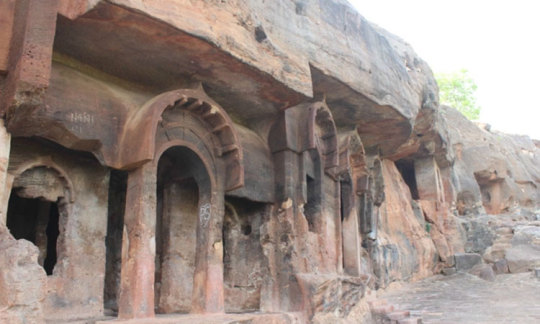
Ramatheertham,
Ramateertham is a village panchayat in Nellimarla mandal of Vizianagaram district in Andhra Pradesh in India.It is about 12 km from Vizianagaram city. It is a famous Pilgrimage and also Ancient Historical Site since 3rd Century BCE.Ramateertham is one of the places made sacred by a traditional connection with Rama. The temple and village at the base of a chain of hills of solid rock on which are some perennial springs of water, and various places each in a way associated with the name of Rama. The Jains have also had a residence here, their remains consisting chiefly of natural caves with slab sculptures set in them, and some small ruined brick temples. It is one of the few places in this direction where Jaina remains exist. The only notice of buried remains here is in Sewel's Lists (Vol. I, page 15) where mention is made of great heaps of broken bricks and cut stones on a hill which is difficult of access. It was hitherto unknown that these remains were Buddhist, and this I only discovered last season. Since that time, excavations have been conducted and resulted in the unearthing of an extensive part of what has undoubtedly been a large and important Buddhist monastery.
The Black Granite hills on which you can find the ruins of some Buddhist and Jain structures known as Bodhikonda. Apart from it there are two other hills by name Gurabaktakonda (Gurubhakthulakonda) and Ghani konda (also known as Durga Konda) on which you can find a 3rd-century BC Buddhist Monastic complex remains and rock-cut caves with Jain Tirthankara images on the walls of the caves.
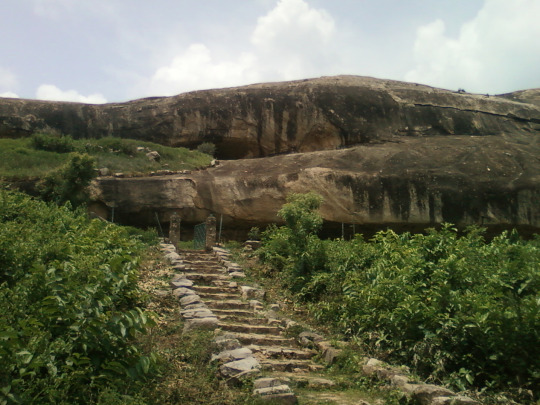
Aihole
Aihole (pronounced "Eye-hoḷé"), also referred to as Aivalli, Ahivolal or Aryapura, is a historic site of ancient and medieval era Buddhist, Hindu and Jain monuments in Karnataka, India dated from the sixth century through the twelfth century CE, though the most of the surviving monuments date from the 7th to 10th centuries. Located around an eponymous small village surrounded by farmlands and sandstone hills, Aihole is a major archaeological site featuring over one hundred and twenty stone and cave temples from this period, spread along the Malaprabha river valley, in Bagalakote district.Aihole is 22 miles (35 km) from Badami and about 6 miles (9.7 km) from Pattadakal, both of which are major centres of historically important Chalukya monuments. Aihole, along with nearby Badami (Vatapi), emerged by the 6th century as the cradle of experimentation with temple architecture, stone artwork, and construction techniques. This resulted in 16 types of free-standing temples and 4 types of rock-cut shrines. The experimentation in architecture and arts that began in Aihole yielded the group of monuments at Pattadakal, a UNESCO world heritage site.
Over one hundred Aihole temples are Hindu, a few are Jain and one is Buddhist. These were built and coexisted in close proximity. The site is spread over about 5 square kilometres (1.9 sq mi). The Hindu temples are dedicated to Shiva, Vishnu, Durga, Surya and other Hindu deities. The Jain Basadi temples are dedicated to Mahavira, Parshvanatha, Neminatha and other Jain Tirthankaras.[10] The Buddhist monument is a temple and small monastery. Both Hindu and Jain monuments include monasteries, as well as social utilities such as stepwell water tanks with artistic carvings near major temples.
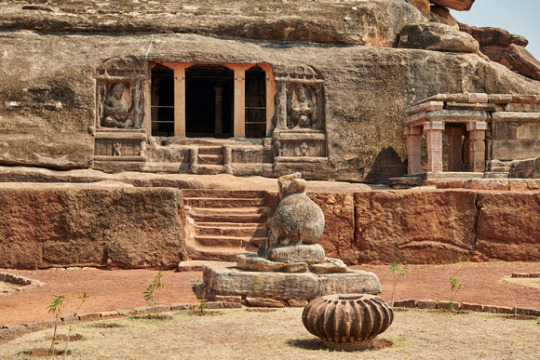
1 note
·
View note
Text
Akshardham Temple: Epitome of Spirituality & Culture at Delhi

Swaminarayan Akshardham Temple is one of the most divine temple of India and it is located in Delhi, India. This Hindu temple depicts Indian culture, architecture and spirituality. Akshardham means the divine abode of God. This temple was constructed in 2005 for giving a tribute to "Bhagwan Swaminarayan" who belongs to the 18th century. A trip to Akshardham temple is not only considered to be a pilgrimage tour, but also a historical journey that will leave you truly astonished. Explore the pilgrimage, peace and purity, nearby beautiful places and learn about devotional traditions. The spiritual traditions followed here are relics of 10,000 year old Indian culture. If you are touring Delhi, Akshardham Temple is a must. Let's discover the other aspects of Akshardham Temple
Point of Attractions At Akshardham Temple
There are many other things apart from the temple complex which you can view. There are many shows organized inside the temple for the audience to make them aware of the traditions and culture. Apart from this, water shows, cultural boat ride, IMAX film dedicated to the life of Swaminarayan is shown to the tourists.

Swaminarayan Akshardham Temple Complex, Via: akshardham.com The complex of this temple is very beautiful and is the main attraction. There are carved statues of dancers, deities and filled with flora and fauna. The special thing about the temple is that it is standing on 234 pillars with 9 domes and consists of 2000 deity statues. The whole temple is built with "Rajasthani Sandstone" and Italian "Carrara Marble". 1. Hall of Values: Also known as "Sahajanand Darshan" shows the life of Swaminarayan with a robotics display. There are 3D figures that use light and sound effects, music and dialogues. This hall of values holds the smallest robot in the world of Shanshyam Maharaj, the child version of Swaminarayan.

Sanskruti Darshan at Akshardham Temple, Via: akshardham.com 2. Nilkanth Darshan: It is a theatre that shows pilgrimage undertaken by Swaminarayan. There is a large bronze statue of a Hindu deity outside the theatre. 3. Enjoy the cultural boat ride of 15min, on this ride you got to know the lifestyle of Indians during the Vedic period through robots. It also displays the world’s first university, Takshashila. 4. Yagnapurush Kund: Also known as the musical fountain, it is the largest stepwell in the country. In the morning, pilgrims rest there and later in the evening, a grand water show is organized for 24mins depicting the life of Hindu saints. The musical fountain includes water jets, underwater flames and live actors.

The musical fountain & light show, Via: akshardham.com 5. Premvati Ahargruh: Taste the best food at this food court which is located inside the temple. It is designed on the theme of Ajanta and Ellora caves. 6. Narayan Sarovar: Narayan Sarovar is a sacred water body surrounding the main Akshardham mandir. Narayan Sarovar contains the holy waters of 151 rivers and lakes pious by Bhagwan Swaminarayan, including Manasarovar, Pushkar Sarovar, Pampa Sarovar, Indradyumna Sarovar, Manikarnika Ghat, Prayag Triveni Sangam, River Kshipra, Rivers Ganga and the Yamuna and many others.

Theme garden at Akshardham Temple-Delhi, Via: pinterest.com 7. Bharat Upavan: It is also known the Garden of India spread in an area of 60 acres filled with bronze sculptures of the various genres like the deity, freedom fighters, warrior and national personalities of India. Also Read: Red Fort of Delhi – Most Magnificent Palace of India
Best Time To Visit
Akshardham Temple is open throughout the year. Walking through the temple is done barefoot so you can avoid the summer season. Similarly, the monsoon season is the worst time to visit the temple. The best time to visit the temple is the winter season, which starts in October and ends in February. Best Months: February - April, August – November It is better to visit during early hours of the evening, as you will have enough time to explore all the attractions and it will be easy for you to attend the musical fountain.
Modes of Reaching
The best way to reach the temple complex is through the metro train. But if you are traveling from other states of India then "Indira Gandhi International Airport" is the nearest airport, located about 21kms from the temple. The nearest metro station is "Akshardham", which is right outside the temple.

Blue Line Akshardham Metro Station, Via: dfordelhi.in You can also find buses, cabs and autos from various parts of the city to reach the temple.
Visiting Time & Other Details
There are some general details that everyone should know while visiting the Akshardham temple. Address: On NH 24, Akshardham Setu, Delhi, India Visiting Time: 9:30 AM to 8:00 PM From Tuesday to Sunday, Monday closed Aarti Timings: 10:00 AM to 6:00 PM Temple Entry Fee: Free Mobiles and Electronics: Not allowed Water Show: Sahaj Anand Water Show Exhibitions: 1) Sahaajand Darshan 2) Sanskruti Darshan 3) Neelkanth Darshan Entry Fee Details: The exhibition tickets are sold between 10 AM and 5 PM. Cost of Exhibition Adult - ₹170, Children below 11 years – ₹ 100, Children below 4 years – Free Senior Citizen – ₹125 Cost of Musical Fountain Adult – ₹30, Children below 11 years – ₹20, Children below 4 years – Free
Places to Visit Near Akshardham Temple
Sanjay Park Red Fort India Gate Shri Balaji Mandir Visiting Swaminarayan Akshardham in Delhi is a journey into the heart of ancient India. So, keep aside a day in your tour & explore this major attraction in the national capital. Read the full article
0 notes
Text
updates 1/2 - Goa
Our Diwali break started Friday. Our weekly Friday excursion was put aside and we had a party in the afternoon instead. I wore my sari which was finished just in time for the party; it’s a pale blue-grey with gold stripes. I’ll post a picture (I keep saying that. I’ll actually do that today). We introduced all of our host parents to the other students, and our parents introduced us to the other parents. It seemed like everyone was matched with their family really well and everyone is settled now. I feel a little more settled, anyway. I still get homesick, especially lately, but the semester is officially half over. A lot has happened since my last post so I’m not sure where to start, chronologically. I guess I’ll just type and see where it takes me.
The last weekend of September, most of us students took a holiday in Goa since we had that Monday off. We had to book a random, inexpensive hotel last minute because we waited too long to book the original one we were looking at and it was taken by someone else. After a very long, twelve-hour bus ride, we arrived in Goa near Baga beach Saturday morning. We were able to check in early to the rooms we booked: two rooms for the 11 of us. The rooms each came with a pretty large bed, but the people renting out the room gave us extra mattresses to lay on the floor. My room had five people, with me and the other two girls on the bed and two of our three boys on the floor mattresses. Sharing the room, bathroom, and deciding what to do with the air conditioning (everyone but one person wanted it off; too cold) took some adjusting but it didn’t become too big of a problem since we were there only two nights. Saturday we went to the beach, which the room owner said was a mere five minute walk from where we stayed. It was at least 15 minutes, maybe more depending on the heavy traffic that squeezed through the small, very muddy streets near the beach. The water was salty and a perfect temperature. The sand was fine and not too hot to stand on barefoot. We had been told that the farther south you go in India, the less people stare or take photos without permission. I thought maybe Goa was south enough of Maharashtra that we could escape the unwanted attention like we had received at Ajanta-Ellora. Not south enough, it turned out. Later, a friend told me that south Goa beaches, the ones meant for tourists and rich people, are safer and kinder to travelers. Oh well, next time.
Saturday night in Goa was fun though. I went to my first nightclub (ever) after we had dinner at a restaurant which served cheap, strong drinks. I might’ve gotten more than tipsy that night. The first club we went to was very small but being a group of Americans comes with perks, I guess. They first gave us a free round of shots, then a *whole* free bottle of sprite and vodka. I was more interested in dancing, for the record, if my family happens to read this.We stayed there a while and then moved on to the famous club in the area, Tito’s. I broke my shoe while dancing there and the lady checking bags confiscated an apple that I had bought earlier in the night for breakfast the next day. A stray dog laid at the base of the steps going up to the dance floor and I thought it must be so loud for it to lay there, but when we came down to leave later it was gone. The bag-checking lady still had my apple when I left and I took it, proud of intoxicated-me for looking out for morning-after me by providing a healthy breakfast. In the morning, I woke up early and with an unhappy stomach. The first bite of my apple hit a rotten spot, but I thought nothing of it and decided to eat around the spot. A few bites later I realized the apple was inhabited by worms. Many worms. I walked down the road to find a different breakfast.
The rest of the weekend was somewhat uneventful, but welcome after all the work we were doing for our classes. We had lunch at another well-known place and a few of us walked around shops for a while before heading to the beach one last time. The day before I had worn my one-piece swimsuit with shorts over it but that didn’t stop a group of guys around our age from harassing us. They circled around us in the water when we didn’t even look their way and splashed us in the face. The saltwater hurt my eyes but I’m glad they didn’t try anything else. Sunday, I skipped the swimsuit altogether and wore a new tourist-y Goa t-shirt with loose, black pants and just stood in the water up to my knees. Nearby, two of the other girls from our group were repeatedly telling another group of men that they don’t want their picture taken when one of them threw sand at their faces. We left soon after that. A few of us were expertly pressured into buying some anklets from women selling mostly to foreigners. They said things like, “Your skin is so fair and pretty! Not like us, we look like monkeys.” We were all made uncomfortable by this and I wasn’t sure if they believed it as a result of the colorism that came during the colonial times or if it was just a clever compliment to boost sales. I can’t say for sure but I think about it often.
The next morning, we left with our hired bus driver to begin the long drive home. Home, because that’s what Pune is feeling like now. Especially after going out of state where we could not communicate with the little Marathi we had learned. In only three or four days I had started to miss the pace of the city and the routine I had settled into. And I missed my ai’s cooking, and watching Marathi serials with them at dinner. I can’t wait to get home, real home, and see my real mother and my dogs and all my friends at school. But I can tell that leaving Pune will also be very difficult. I have friends here now, and a temporary family. I look for familiar stray dogs when visiting different parts of the city. I know where to find the most reliable rickshaws, and I know how to tell them when they’ve charged me too much. People look surprised when I show understanding when listening to a conversation, and when I even contribute to it. I feel like part of me has rooted here, fed by the daily rains that should have stopped with monsoon season. Before I know it, it’ll be time to dig them up again to board a flight back to the US.
1 note
·
View note
Text
KHAJURAHO - The UNESCO World Heritage site in Central India
Visit India is always a great plan if you are touring with right tour operators. The country is full of vivid historic and modern tourist attractions. But when we talk about the rarest and splendid places in the Indian subcontinent, how can we miss the UNESCO world heritage sites? Have you visited those places? Here is the whole information you need to gather:
The World Heritages Sites to Visit in Central India are:
The important UNESCO world heritage sites are Agra fort, Ajanta, Ellora, Sanchi stupas, Red Fort etc. These all places come under central India Tour and these are form the best holiday packages in India.
Varanasi:
Varanasi is known as Banaras in ancient days, now days it is also known as kashi which is located on the banks of river Ganga in the state of Uttar Pradesh. Lucknow is the capital city of Varanasi, which is located 320 kms away from the capital city in the direction of the southeast. This is known as one of the important holy place in India and it can be considered as best tour operator in India.

Varanasi is highly grown up in the sector of industries and is famous for Muslim and Sikh fabrics. Tourists can visit Varanasi at any time; there is no any specific time to visit India. This temple came into growth from 8 th century. When Adishankara established to worship Lord Shiva, though the Muslim rule was in existence the city continued in the praying Hindu god and many Muslim rulers, magicians contributed to its reputation which is known as the Center for the importance of culture and for the purpose of religious education.
Varanasi tour package is very low cost. The great poet Tulsidas wrote a famous poem known as 'ramcharithmanas' in this holy city. Several Bhakti movements came into existence in this holy city. Guru Nanak visited the holy city in the year 1507 AD on Maha Shivaratri day. This trip played an important role in the foundation of Sikhism. Varanasi is a cultural centre for north India for several thousands of years. This city consists of many Ghats some of them are Dashashwamedh ghat, Panchaganga ghat, Manikarnika ghat and Harishchandra ghat.
There was a fort called Ramnagar Fort, which was built in the 18 th century, which is in the style of Mughal architecture. There are about 23, 0000 temples in Varanasi. Most famous residential Asia's largest university which is known as Banaras Hindu University (BHU) is located in this city. There are many best holiday packages in India in Varanasi. Varanasi tour package is very devotional. Varanasi tour packages consist of all the nearby places surrounded there.
KHAJURAHO
Khajuraho is located in Madhya Pradesh which has a group of Hindu and Jain temples. It is situated 175 km southeast of Jhansi. Khajuraho is one of the UNESCO World Health Sites in India. The temples of Khajuraho are famous for erotic sculptures and symbolize nagara - style architectural system.

Most of the temples in Khajuraho are built during the rule of Chandela dynasty in the period of 950 to 1050. Historical records say that Khajuraho has 85 temples by 12th century and these temples spread over 20 square kms. According to present historical survey only 25 temples came into existence. These temples were spread over 6 square kms in the town. Among the survived temples in Khajuraho, the famous temple is known as the Kandriya Mahadeva temple which is decorated with a profusion of sculptures, expressiveness of ancient Indian art and symbolism.
The temples which are built in Khajuraho are meant to two religions, which are for Hinduism and Jainism. The temples of this place embarrass the mark of Hindus and Jains. This place is known as the best tour operator in India. There is no any specific time to visit India as people can visit at any time.
ORCHHA:
Orchha is situated in Tikamgarh district of Madhya Pradesh state. Orchha town was established by the great ruler called Rudra Pratap Singh around the time of 1501 AD in the region of Bundelkand. Orchha lies on the banks of the river Betwa which is 80 kms from Tikamgarh and 15 kms from Jhansi, which is located in Uttar Pradesh.

The king of Orchha Rudra Pratap Singh built a fort called Orchha fort along this city in his period. The Chaturbhuj temple was built by the queen of Orchha Ganesh Bhai during the period of Akbar and Raj Mandir was also built during the period of Akbar from the year 1554 AD to 1591 AD. River Betwa is surrounded by battlement of walls, which stands as a mark of the huge palace fort. This fort consists of several buildings, among those buildings the famous and noteworthy is known as Raja Mahal. Some of the famous places are Ram Raja temple, Jahangir Mahal, Chaturbhuj temple etc.
Have you visited the central India or not? If not yet, you should pack your bags right now. Even if you have visited, there are always new things to explore. So, book your Central India Tour Package with VUE India Tour Package now.
0 notes
Text
Ajanta and Ellora Caves
You can find here how to reach Ajanta and Ellora #tourist_attractions of Ajanta and Ellora, the best time to visit Ajanta and Ellora, weather of Ajanta and Ellora, #Buddhist_Temples of Ajanta and Ellora, the nearest airport to Ajanta and Ellora, nearby tourist places to #Ajanta and #Elloraand much more. Buddhist Tour In India offers Ajanta and Ellora Tour in the best budget.
Contact: +91-9711845432 / +91-9616731175
Link: http://buddhisttourinindia.com/buddhist-pilgrimage-destination/about-ajanta-ellora-buddhist-places-maharashtra-india.aspx

#Ajanta and Ellora Caves#Ajanta Caves#Ellora Caves#buddhist tour in india#Buddhist pilgrimage#buddhist package
1 note
·
View note